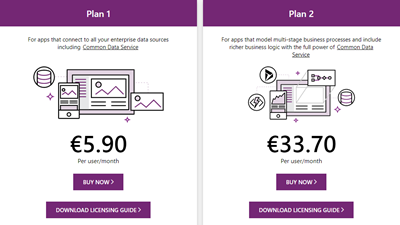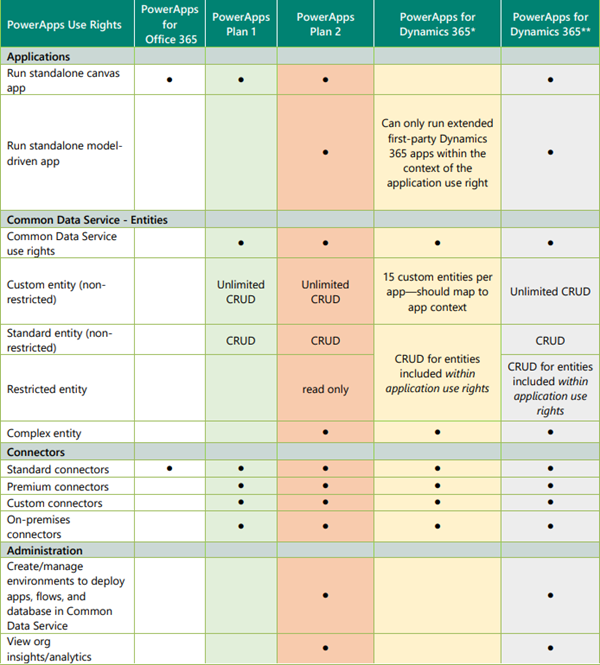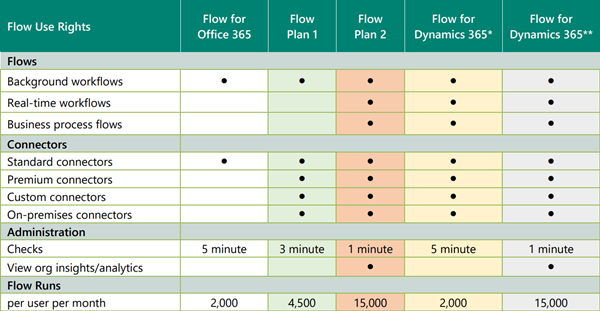Effective October 1, 2019, the new licensing model for Microsoft PowerApps and Flow will apply. To clarify which functions are included where, we have compiled an overview at a glance here.
To make it short, here are the key data:
- Every user who uses PowerApps or Flow requires a license.
- PowerApps can be tested for free for 30 days.
- PowerApps licenses will continue to include Microsoft Flow capabilities.
- PowerApps and Flow licenses are included in the Office 365 Academic (A), Enterprise (E) and F1 plans - as before. See the complete list at PowerApps licensing overview. So, to create and use a PowerApp or a Flow, the included license is often sufficient.
- Old licenses: Additionally, there exist PowerApps Plan 1 (P1) for 5,90€/user/month and Plan 2 (P2) for 33,70€/user/month for more features and capacity (see the table below). The P1 and P2 plan can be bought as stand-alone license if required.

This summer, PowerApps got a new feature called PowerApps Portals (see here, some news here and the documentation). A PowerApps Portal allows to develop a low-code, responsive websites which allow external users to interact with the data stored in the Common Data Service. This is also reflected in the new licenses.
By October, Microsoft introduces new stand alone plans for PowerApps and Microsoft Flow.
- PowerApps per app plan allows individual users to run applications (2 apps and a single portal) for 8,40€/user/app/month.
- PowerApps per user plan allows a user to run unlimited applications based on the full capabilities for 33,70€/user/month (the former P2 plan)
- Microsoft Flow per user plan allows a user to run unlimited flows with the full capabilities of Microsoft Flow for 13,80€/user/month.
- Microsoft Flow per flow plan enables organizations to implement flows with reserved capacity without having to license each end user. This plan starts at $500/month for 5 flows.
- Existing P1 and P2 plans for PowerApps and Microsoft Flow will be transitioning to the new PowerApps per app and per user plans, as well as the Microsoft Flow per user and per Microsoft Flow plans (see FAQ).
See the current pricing at powerapps.microsoft.com/pricing and a detailed information at the Microsoft PowerApps and Microsoft Flow Licensing Guide PDF document.
For planning new PowerApps or Flow projects, it´s important to understand the supported features and required licenses. See more at Compare features and pricing.
The PDF´s Appendix B: PowerApps Use Rights shows the PowerApps feature matrix:
The PDF´s Appendix C: Flow Use Rights shows the Flow feature matrix:
For example, if you plan to use a PowerApp with a custom connector or using CDS, a P1 license is required for all users working with that PowerApp.
See more at PowerApps and Microsoft Flow licensing FAQs for October 2019.
If you are interested to buy or to extend Microsoft 365 licenses through our membership in the Microsoft CSP program, pls. contact us.
Categories: App, Cloud, English, Developer, Microsoft, Microsoft365, Office365, PowerApps
Source: https://blog.atwork.at/post/Microsoft-PowerApps-and-Flow-licensing

